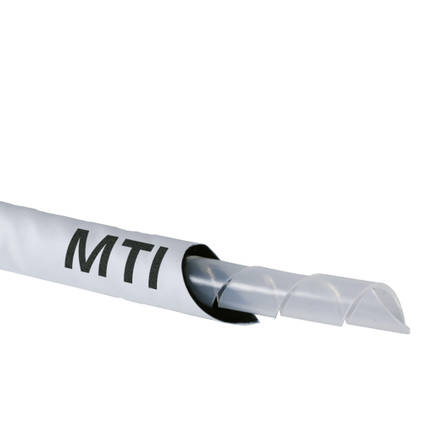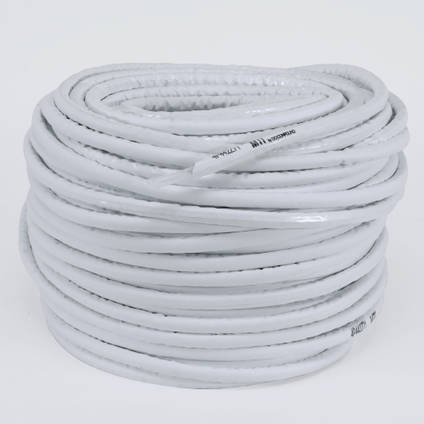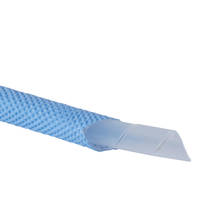Need any help or advice?+44 (0)1782 454499
Downloads (3)
| MTI Hose Safety Data Sheet (SDS) | ||
| MTI Hose Technical Data Sheet (TDS) | ||
| MTI Hose Product Summary |
Specification
Weight and Dimensions
| Inside Diameter (ID) | 8 | mm |
|---|---|---|
| Outside Diameter (OD) | 13 | mm |
Product Data
| Max Service Temp | 80 | °C |
|---|---|---|
| Max Service Temp Of Membrane | 160 | °C |
| Extraction Capacity per m at 50hPa | 20 | i/min |
| Membrane Material | Polyurethane | |
| Non-woven Material | Polyester | |
| Spiral Wrap Material | Polyethylene | |
| Tensile Strength | 20 | N |
General Properties
| Gross Weight | 0.028 | kg |
|---|---|---|
| Brand | DD-Compound |
Shipping Information
Restrictions
This product is not classed as dangerous goods for transport and can be shipped to all destinations without restriction.
Package Size
There are no package size restrictions or surcharges for this product.
Delivery Cost
To find the delivery cost of this item to your address, add it to your basket and then use the instant shipping calculator on the basket page.
MTI® Hose - Microporous Vacuum Line
- DD-Compound
- MP-MTI-H
- 5/5 Average rating
Specifically developed for resin infusion, this high performance semi-permeable vacuum hose uses microporous membrane technology which allows air to pass into the hose whilst allowing only minimal resin transmission.
Genuine MTI® hose manufactured by DD-Compound in Germany. Sold by the linear metre.
AVAILABILITY:More than 50 availablefor immediate shipping
Trade discounts
| 0-4 | 5-9 | 10-99 | 100+ |
|---|---|---|---|
| €4.60 | €4.05 | €3.80 | €3.55 |
We won’t be beaten on price!
If you believe you’re buying an equivalent product cheaper elsewhere, contact us to discuss your requirements.
MTI Hose from DD-Compound is the industry leading microporous vacuum line, it is used in resin infusion to maintain vacuum along its full length throughout the process, this greatly reduces the risk of dry areas in more complex infusions, typically the hose is used for perimeter vacuum on centre or conventionally fed infusions.
Its working principle is like that of breathable waterproof clothing, in that it will allow air to pass through the membrane but effectively seals off when it is reached by the resin front, the spiral that is in the core of the hose will maintain the vacuum to any uninfused areas that would normally have become isolated in a traditional infusion stack.
The MTI hose has an uncompressed outside diameter of ~13mm, the internal spiral hose has an O.D. of 10mm and an I.D. of 8mm.
How to Buy
The MTI Hose is available to purchase by the metre or in wholesale coils of 100m. Prices shown are per meter, volume discounts are automatically calculated.
Volume Pricing
We believe we offer unbeatable prices on vac bagging consumables. To make comparisons easy, select the different pack/roll sizes from the drop-down menu above:
Further Information
Increasing Reliability
MTI Hose will increase the reliability of infusions particularly of new and complex infusions where the precise flow path has not been established, this will reduce the likelihood of scrappage and defects which could offer huge cost savings in production.
Self-Regulating
As the resin flow is almost entirely halted by the MTI hose the timing for clamping the vacuum line is no longer a critical factor in the process meaning that is does not need to be continuously monitored, in fact it is perfectly possible to maintain the vacuum throughout the cure without drawing resin into the vacuum system. Although we would always recommend the use of a catch-pot as a precautionary measure, MTI Hose will generally render a catch-pot redundant so it would be possible to run a direct connection to the vacuum pump.
Since the MTI Hose will not draw off any resin a precise resin to fibre ratio can be achieved by simply measuring the quantity of resin entering the part, this allows for excellent consistency and repeatability between parts.
Typical Use
Typically, the MTI Hose is laid around the perimeter of the moulding wherever vacuum needs to be maintained. The ends of the MTI Hose seal easily and effectively using conventional vacuum bagging sealant tape the vacuum hose connection can be made by feeding the vacuum hose into the MTI Hose and sealing with sealant tape, this vacuum hose would typically breach the bag through the sealant tape on the flange. Note that unlike some of the other products in our microporous range the MTI cannot be easily heat-sealed, however conventional sealant tape can easily achieve a perfect seal unlike with the other materials. Although the hose will still allow for full vacuum to be achieved it will slow the initial pull down time so take care to ensure to bag generally conforms well to the mould before closing to reduce the pull-down time or pre-evacuate the component through the feed line..
Leak Fixing
It is a common misconception that MTI Hose and similar microporous products eliminate the need to ensure that the vacuum bag is perfectly sealed, the (incorrect) theory being that as the vacuum can be maintained through the cure that the bag can be held down even with a leak, although it is true that a microporous vacuum line might be able to help to hold a bag and material roughly in place in the event of a leak it will not do this effectively enough for the part not to be severely compromised. The reason for this is that once the membrane has become 'wetted' with resin it is no longer permeable to air and so you should consider it to be sealed, with this in mind once the part has infused fully the MTI hose will be fully covered in resin and sealed therefore no longer able to draw out the air caused by a leak.
Related Products
MTI Valve - Resin Inlet Regulator
The MTI Valve can be used in conjunction with microporous vacuum lines/strips, its purpose is to create a regulated back pressure on the resin inlet which ensures that the part does not become over-saturated with resin and in turn increases the consistency of infused parts.
After all the reinforcement has become saturated the MTI Hose will no longer be applying high vacuum to the component, this allows any microbubbles to shrink almost completely as opposed to expanding as would typically be seen in a traditional infusion with a resin-brake zone, this effect greatly reduces the potential for voids near the evacuation media.
MVL Hose - Microporous Vacuum Line
MVL is a low-cost alternative to the MTI Hose; MVL in the most part serves the same role as the MTI hose however the membrane used does not completely prevent resin ingress over prolonged periods and end-sealing is slightly more difficult and requires either heat-sealing or a combination of sealant tape and duct tape. As the MVL pores are not completely closed by the resin any air remaining in the part can still be evacuated even when MVL is wetted out by resin.
MVS Microporous Vacuum Strip
MVS is used where vacuum is needed in the centre of the part rather than the perimeter, being flat form it does not cause a 'print-through', this is available in 2 widths; 100 and 300mm.
Trade discounts
| 0-4 | 5-9 | 10-99 | 100+ |
|---|---|---|---|
| €4.60 | €4.05 | €3.80 | €3.55 |
We won’t be beaten on price!
If you believe you’re buying an equivalent product cheaper elsewhere, contact us to discuss your requirements.
MTI Hose from DD-Compound is the industry leading microporous vacuum line, it is used in resin infusion to maintain vacuum along its full length throughout the process, this greatly reduces the risk of dry areas in more complex infusions, typically the hose is used for perimeter vacuum on centre or conventionally fed infusions.
Its working principle is like that of breathable waterproof clothing, in that it will allow air to pass through the membrane but effectively seals off when it is reached by the resin front, the spiral that is in the core of the hose will maintain the vacuum to any uninfused areas that would normally have become isolated in a traditional infusion stack.
The MTI hose has an uncompressed outside diameter of ~13mm, the internal spiral hose has an O.D. of 10mm and an I.D. of 8mm.
How to Buy
The MTI Hose is available to purchase by the metre or in wholesale coils of 100m. Prices shown are per meter, volume discounts are automatically calculated.
Volume Pricing
We believe we offer unbeatable prices on vac bagging consumables. To make comparisons easy, select the different pack/roll sizes from the drop-down menu above:
Further Information
Increasing Reliability
MTI Hose will increase the reliability of infusions particularly of new and complex infusions where the precise flow path has not been established, this will reduce the likelihood of scrappage and defects which could offer huge cost savings in production.
Self-Regulating
As the resin flow is almost entirely halted by the MTI hose the timing for clamping the vacuum line is no longer a critical factor in the process meaning that is does not need to be continuously monitored, in fact it is perfectly possible to maintain the vacuum throughout the cure without drawing resin into the vacuum system. Although we would always recommend the use of a catch-pot as a precautionary measure, MTI Hose will generally render a catch-pot redundant so it would be possible to run a direct connection to the vacuum pump.
Since the MTI Hose will not draw off any resin a precise resin to fibre ratio can be achieved by simply measuring the quantity of resin entering the part, this allows for excellent consistency and repeatability between parts.
Typical Use
Typically, the MTI Hose is laid around the perimeter of the moulding wherever vacuum needs to be maintained. The ends of the MTI Hose seal easily and effectively using conventional vacuum bagging sealant tape the vacuum hose connection can be made by feeding the vacuum hose into the MTI Hose and sealing with sealant tape, this vacuum hose would typically breach the bag through the sealant tape on the flange. Note that unlike some of the other products in our microporous range the MTI cannot be easily heat-sealed, however conventional sealant tape can easily achieve a perfect seal unlike with the other materials. Although the hose will still allow for full vacuum to be achieved it will slow the initial pull down time so take care to ensure to bag generally conforms well to the mould before closing to reduce the pull-down time or pre-evacuate the component through the feed line..
Leak Fixing
It is a common misconception that MTI Hose and similar microporous products eliminate the need to ensure that the vacuum bag is perfectly sealed, the (incorrect) theory being that as the vacuum can be maintained through the cure that the bag can be held down even with a leak, although it is true that a microporous vacuum line might be able to help to hold a bag and material roughly in place in the event of a leak it will not do this effectively enough for the part not to be severely compromised. The reason for this is that once the membrane has become 'wetted' with resin it is no longer permeable to air and so you should consider it to be sealed, with this in mind once the part has infused fully the MTI hose will be fully covered in resin and sealed therefore no longer able to draw out the air caused by a leak.
Related Products
MTI Valve - Resin Inlet Regulator
The MTI Valve can be used in conjunction with microporous vacuum lines/strips, its purpose is to create a regulated back pressure on the resin inlet which ensures that the part does not become over-saturated with resin and in turn increases the consistency of infused parts.
After all the reinforcement has become saturated the MTI Hose will no longer be applying high vacuum to the component, this allows any microbubbles to shrink almost completely as opposed to expanding as would typically be seen in a traditional infusion with a resin-brake zone, this effect greatly reduces the potential for voids near the evacuation media.
MVL Hose - Microporous Vacuum Line
MVL is a low-cost alternative to the MTI Hose; MVL in the most part serves the same role as the MTI hose however the membrane used does not completely prevent resin ingress over prolonged periods and end-sealing is slightly more difficult and requires either heat-sealing or a combination of sealant tape and duct tape. As the MVL pores are not completely closed by the resin any air remaining in the part can still be evacuated even when MVL is wetted out by resin.
MVS Microporous Vacuum Strip
MVS is used where vacuum is needed in the centre of the part rather than the perimeter, being flat form it does not cause a 'print-through', this is available in 2 widths; 100 and 300mm.
Specification
Weight and Dimensions
| Inside Diameter (ID) | 8 | mm |
|---|---|---|
| Outside Diameter (OD) | 13 | mm |
Product Data
| Max Service Temp | 80 | °C |
|---|---|---|
| Max Service Temp Of Membrane | 160 | °C |
| Extraction Capacity per m at 50hPa | 20 | i/min |
| Membrane Material | Polyurethane | |
| Non-woven Material | Polyester | |
| Spiral Wrap Material | Polyethylene | |
| Tensile Strength | 20 | N |
General Properties
| Gross Weight | 0.028 | kg |
|---|---|---|
| Brand | DD-Compound |
ASK YOUR OWN QUESTION
Customer Product Reviews for MTI® Hose - Microporous Vacuum Line
I did my first ever polyester/GRP infusion on a split mould not designed for infusion, the gel coat sealed the split in the mould and I made a bag to fully enclose it, then used the MTI hose round the edge, it worked perfectly. Awesome product!
SUBMIT YOUR OWN PRODUCT REVIEW
We publish all reviews for verified purchases. Submit your own review and help other customers with their choices.SUBMIT YOUR OWN PRODUCT REVIEW
We publish all reviews for verified purchases. Submit your own review and help other customers with their choices.Shipping Information
Restrictions
This product is not classed as dangerous goods for transport and can be shipped to all destinations without restriction.
Package Size
There are no package size restrictions or surcharges for this product.
Delivery Cost
To find the delivery cost of this item to your address, add it to your basket and then use the instant shipping calculator on the basket page.
RELATED PRODUCTS
CUSTOMERS ALSO PURCHASED
RELATED PRODUCTS
CUSTOMERS ALSO PURCHASED
100% SECURE
PAYMENT METHODS
Easy Composites EU B.V., registered in the Netherlands 73601195. All content copyright (C) Easy Composites Ltd, 2025. All rights reserved.




